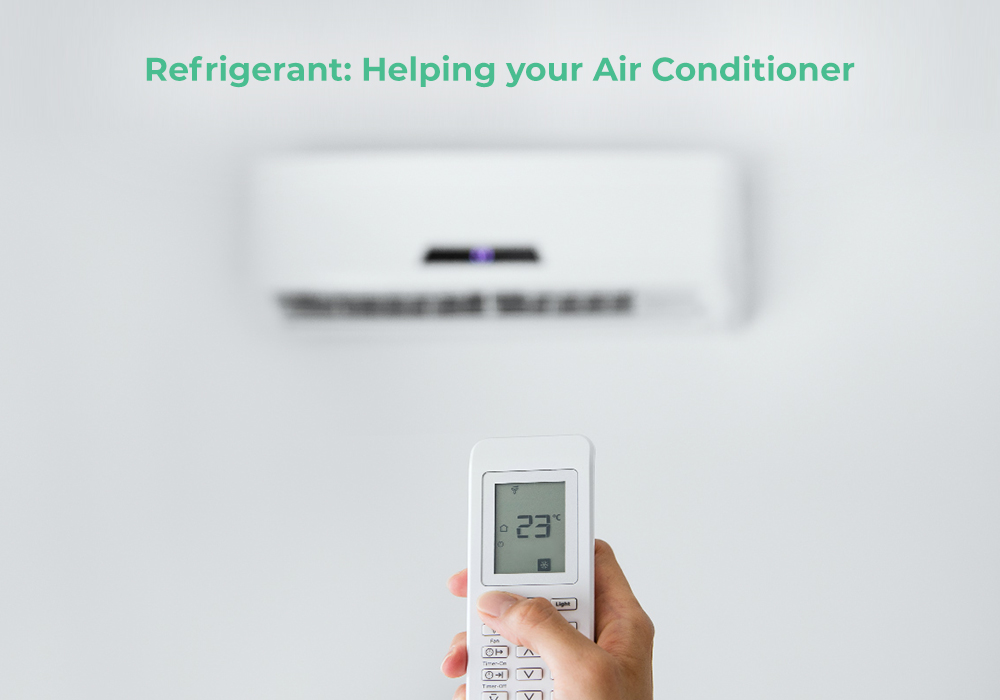What is a refrigerant?
A refrigerant is a fluid compound used in a heat cycle to transfer/remove heat from one particular area to another, when used in conjunction with other components like compressors or evaporators. Transfer/removal of heat from the area results in its cooling (or refrigeration of air conditioning).
These refrigerants are used in air conditioners, refrigerators, walk-in freezers — almost anything that controls temperature for cooling.
Major categories of refrigerants
Major categories of refrigerants are as follows:
- Hydrochlorofluorocarbons (HCFCs):
HCFCs are compounds consisting of hydrogen, chlorine, fluorine and carbon atoms. HCFC refrigerants have medium ODP and medium to high GWP; often used in refrigerant and air conditioning equipment.
Examples: R22, R141b
- Hydrofluorocarbons (HFCs):
A combination of fluorinated hydrocarbons, HFCs have zero ODP and medium to high GWP thus offering a more environment friendly alternative to HCFCs.
Examples: R32, R134a
- Hydrofluoroolefins (HFOs):
HFOs are composed of hydrogen, fluorine and carbon atoms connected by single bonds between the atoms. HFO refrigerants have zero ODP & low GWP and thus offer a more environmental friendly alternative to HCFCs and HFCs.
Example: R452a, HFO1234yf, HFO1234ze, HFO1234yz
Criteria for refrigerant selection
Refrigerant gases suppliers know that virtually all of the refrigerant gas experience in the AC and refrigeration industry has been single component refrigerant or pure refrigerant. However, manufacturers of refrigeration gases have been unsuccessful in developing pure refrigerants that meet all the characteristics for a widely used refrigerant as enumerated:
- Environmental acceptability
- Chemical stability
- Materials compatibility
- Refrigeration-cycle performance
- Boiling point
- Adherence to nonflammable & nontoxic guidelines
The replacement refrigerants are usually azeotropes, zeotropes or near-azeotropes, or of two or more compounds. The industry has considerable experience with each of these types.
The components of a refrigerant are chosen based on the final characteristics, as desired, which could be vapor pressure, transport properties, lubricant and material compatibility, thermodynamic performance, toxicity & stability etc.
Several HFC (Hydrofluorocarbon) refrigerants have emerged as replacement candidates for the commonly used refrigerant, R-22 (it is currently being phased out under Montreal Protocol). However, HFCs have various safety issues to be paid attention to:
- Pressure: HFC refrigerants operate at comparatively higher pressure and can’t be used as retrofit refrigerant.
- Material Compatibility: As materials (such as motor insulation) deteriorate, it can lead to electrical shorts. Leak is also possible after seals have deteriorated as well.
- Flammability: Leakage of flammable refrigerant can result into fire or explosion. Many of the replacement refrigerants are zeotropes which can change composition under leakage situations. This aspect needs consideration.
- Toxicity: Some countries have explored and implemented toxic refrigerant options like ammonia while transitioning from HCFCs and CFCs to HFCs. Notwithstanding ammonia’s system performance benefits, it is highly dangerous if it leaks out accidently.
With special regards to toxicity of new refrigerants, the Threshold Limit Value (TLV) minus Time Weighted Average (TWA) should be less than 400 parts per million (ppm), in addition to being non-flammable.
Also, the performance of the alternative refrigerant must be similar to the refrigerant it is replacing.
According to each of the factors listed above, the American Society of Heating, Refrigerating and Air-Conditioning Engineers (ASHRAE) have studied and rated safety aspects of the proposed chlorine-free new refrigerants for replacing R-22.
These chlorine free refrigeration gases are R-404a, R-134a, R-410A, R-407C, R-290 (Propane) and R-717 (Ammonia). The intent is to use only those replacement refrigerants which are at least as safe as the pure refrigerants.
Other criteria with respect to refrigerant gases may include:
- shifting legislative environment,
- phasing out of HCFC refrigerant gases
- availability of replacement refrigerant gases
- GWP (Global Warming Potential)
- ODP (Ozone Depletion Potential)
- availability of lubricant that works with all alternative refrigerants
How is a refrigerant used in an air conditioner?
Simply stated, an air conditioner has 3 components:
- Compressor
- Condenser
- Evaporator
Compressor highly pressurizes the refrigerant (present in copper coils) in its gaseous phase, making the refrigerant absorb heat from surrounding & change phase to highly pressurized liquid. From there, it moves to the condenser where blower motor expels the heat which the refrigerant fluid has gathered. The refrigerant then cools down and moves to the evaporator where it turns back into a low-pressure gas.
This process facilitates a temperature drop, cooling the coils. A fan blows over these cooled coils to provide cool air inside the home.
Gorakhram Haribux (GH) has 60 years’ worth of experience & leadership in promoting and supplying environment friendly non-ozone depleting refrigerants used in refrigeration and air conditioning.
We offer direct replacement or substitutes for refrigerants which are getting phased out over time. We cater to automotive refrigeration requirements as well, in addition to cold storage, commercial & retail air conditioning, life sciences & biomedical labs etc.
GH also extends its service to clients with smaller volume requirements. For more info, check out our refrigerants and their various applications.

